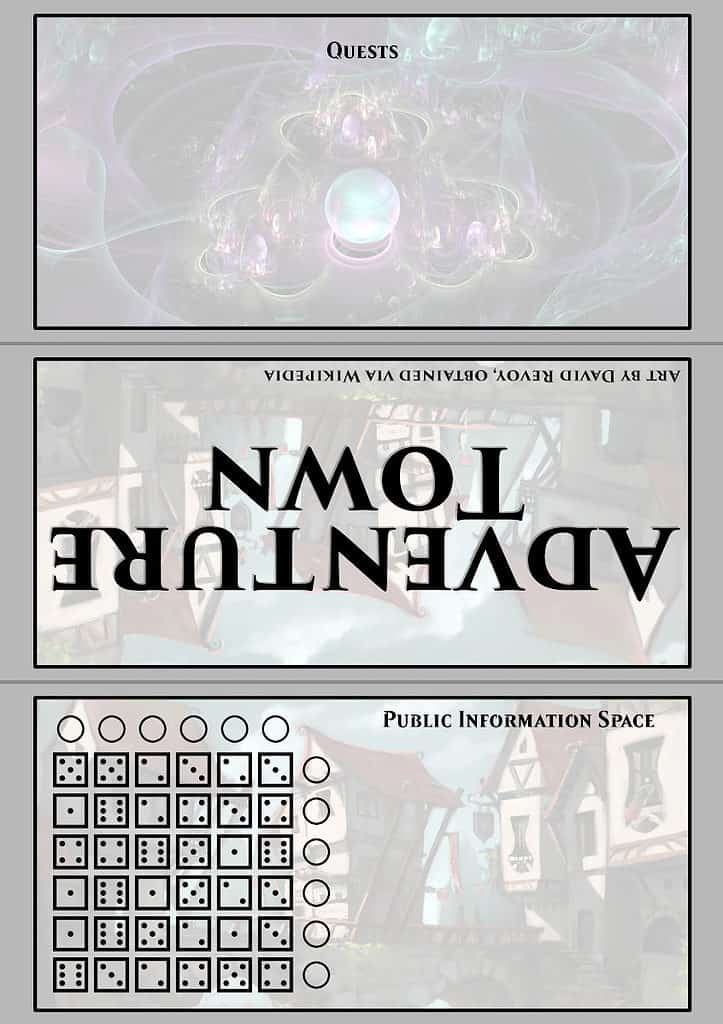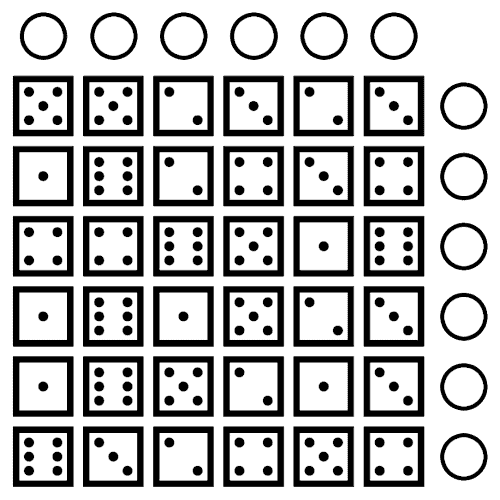Adventure Town is a roll-and-write game about running a town that adventurers pass through, a type of thing that I seem to find really fascinating.
Gunna level with you: I had a lot of writing to do this month. I work on it a little bit at a time, trying to find time to make pushes to finish it, especially since it seems to me to be a really easy project to just get finished, but tell you what: I haven’t had the time in January. This is life, and part of my life in January was a combination of helping someone move, a convention, and a lot of writing for the most important project of my life.
Adventure Town suffered. But it didn’t get nothing done. Particularly, what got done was a very important thing, in my mind: I stopped trying to make perfect mechanics, and managed to instead, get some good mechanics down.
Here’s the updated player sheet, the thing you’re meant to print. There’s going to be a version of it without background graphics, and I need to redo the logo panel, because it’s made with a font I can’t identify any more. But check out down in the bottom panel, the panel that gets folded outside where everyone can see it.
Here’s a close-up on the field that’s there.
This grid represents the die rolls that you make throughout the game; every time you roll a number, you can cross it off the grid. You can also, if you use most of a line so that only one single number is left visible (like, say, two 1s or one 6) when you do roll that number, you can cross them all off, and the line bubble at the side, and get a bonus equal to the number of tiles you’ve crossed out.
Now you may be wondering why I’m so proud of this. It’s because this grid is the thing that’s been holding me back for so long. I couldn’t think of how I was going to structure this so it had both all the numbers in it, and presented an interesting puzzle without becoming too orderly and boring. Wanna know what principle makes this grid work? How I got it to work this way…?
I randomised it.
Just straight up, randomised the unicode in excel, and dumped it into a grid.
The result is a little weird and uneven. In a more full-fledged release, I will probably do a few versions of that grid, maybe even making it so the ‘secret’ panel doesn’t let you choose your heroes for your quest! But the point here is that this little rolling panel is finally made and all it took was admitting to myself that just because I had design space, didn’t mean I needed to be clever about filling it.
In addition to that, here’s the state of the rules so far, as written:
Components
In your copy of GAME, you need the following:
- A deck of cards with all but the face cards (Jack, Queen, King), Ace cards, and Joker cards removed.
- A number of six-sided dice equal to two for each player.
- One town sheet for the players to share
- One player sheet for each player
- A writing device for each player, like pens, pencils, crayons or possibly some form of arcane burin
- Counters to represent coins
How To Play
GAME is a roll-and-write dice-drafting game where all the players are going to be playing as interested parties trying to build up the town and turn it into a thriving village that relies on the travelling adventurers that move through the town. To that end, all you need to start with to build a town around is an inn for them to meet in.
Setup
Take the player boards and fold them up so that players can track their numbers privately. Set the Town sheet in the middle of everyone, where players can check it regularly. Turn the Ace and Joker cards face-up, then shuffle all the cards together. Then, each player selects two of the squares on their player sheet and cross them off, indicating the money that helped start up the town. Count a number of dice equal to the number of players. This is the dice pool.
Each player looks at the secret, folded-in section of their player board, and selects the four heroes they want to be part of their quest, marking them off, and for each hero, they write a number 2 through 5.
Then, select a first leader, and start the game.
Play
The game takes place in turns with one player leading.
- First, the leader takes the dice pool and rolls all the dice.
- Starting with the leader, each player takes one of the dice out of the rolled pool. Once all the dice are chosen, players can spend them on their player board.
- You can cross off a single die on your grid on your board that matches the die you drafted. You get 1 coin for this. If you’ve drafted multiple dice, you can cross off one number that matches each dice.
- If on your board, you have a vertical line or horizontal row where all the un-crossed numbers match, and you have a die of that number, you can cross the marker at the end of the row, and get a bonus payment of one coin for each crossed-out dice. Cross the remaining numbers in that line or row.
- Once each player has spent their dice, starting with the lead player, players can invest money into improving the town.
- You can build a building by paying its cost, on the tile. Initial the buildings you own.
- You can pass and save your coins
- Once each player has either made an investment or passed, the lead player flips the top card of the deck to see which adventurer stops by the town.
- Hearts, representing Holy heroes.
- Jack: The Avenger.
- Queen: The Paladin.
- King: The Cleric.
- Diamonds, representing Mercantile heroes
- Jack: The Rogue.
- Queen: The Warrior.
- King: The Marshall.
- Clubs, representing Natural heroes
- Jack: The Ranger.
- Queen: The Barbarian.
- King: The Druid.
- Spades, representing Arcane heroes.
- Jack: The Wizard.
- Queen: The Spellsword.
- King: The Bard.
- If the top card of the deck is a face-up Ace, that player sets it face up in the discard pile and flip the top card of the deck to see what adventurer is coming instead. That ace is now active in the deck.
- If the top card of the deck is a face-up joker and there are no face-up aces left in the deck, put it in the discard face-up and flip the top card of the deck instead. That joker is now active in the deck.
- If you flip an active Ace, flip cards from the top of your deck until you reveal two adventurers, who come to town together and both trigger.
- If you flip an active Joker, flip cards from the top of your deck until you reveal three adventurers, who come to town together and all trigger.
- Each hero visits the buildings that match their suit and their rank. If a hero in your Quest visits one of the businesses you own, and you have a dice drafted that matches the number on your secret quest area, you can cross that hero off. You can only do this with one adventurer per round, and your buildings can only give one section of the quest (meaning you need at least four buildings to give your quest out in full). You can spend one coin to change the number of your dice by one up or down (once).
- Hearts, representing Holy heroes.
- After the adventurers trigger, put all the adventurer cards from this turn into a discard pile. If at any time you need to do anything with the cards in the deck and it’s empty, shuffle the discard pile and use it to replace the deck.
- Do this only when the whole deck is empty – so if you need to flip three adventurers (for example) off the top of the deck, and you flip two then the deck is empty, shuffle the discard pile, make a new deck with it, and flip the top cards of it until you find that third adventurer.
- With the adventurers done with the town, the lead player passes the dice pool to the next player and they’re the lead player. A new round begins.
Winning
A player wins the game when they mark off a complete Quest, at the end of the turn. It’s possible for multiple players to win the game at the same time. If this bothers you, I recommend solving it by stabbing one another.


